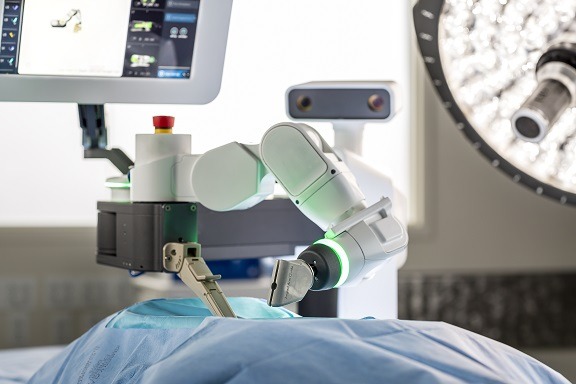
Dennis DeVito has worked with Mazor Robotics’ Rennaisance system for over a decade. In advance of the commercial launch of the new Mazor X, he gives Spinal News International an exclusive first look at the technology, and explains the advances such platforms can bring to spinal surgery.
What opportunities can robotic systems bring to spinal surgery?
Robotics brings several advances to spinal surgery, starting with the most accurate technique for placing pedicle screw implants, especially in the deformed spine. Pre-planning software allows for better surgeon preparedness for the operating room case, adding an element of efficiency to operating room work flow. Time is not wasted trying to decide screw trajectories, sizes, or deciding which vertebrae can be safely instrumented. In multilevel instrumentation, overall operating room time is also reduced with the assistance of robotic guidance.
The Mazor X system readily supports less invasive implant insertions, especially with difficult techniques like S2 alar-iliac (S2AI) pelvic screws, which can be placed percutaneously. It requires significantly less use of intra-operative fluoroscopy. Finally, better surgeon ergonomics are realised, for example, pilot holes are created with a drill, less surgeon fatigue and greater consistency with multilevel screw insertions and multiple cases in the same day.
What distinguishes the Mazor X from other robotic systems?
There are several distinctions from other computer assisted navigation systems. The first has to do with registration—the Mazor correlates individual vertebra by volumetric recognition rather than paired point matching (surface anatomy dependent) which is operator-dependent and more time consuming. Registration accuracy is not averaged over multiple vertebral segments, nor is accuracy affected by distance from index registration level. It is more of a stereotactic system than a manually-controlled one. The “X” allows for a large range of unrestricted robot arm movement (essentially 180 degrees), moves quickly from segment to segment, and is very stable. Patients can be positioned prone or lateral.
In addition, there is also a navigation feature to the Mazor X, allowing for confirmation of robotic guidance, for those surgeons learning the technique.
What experience have you had with the system so far?
I have over 10 years’ experience (525 spinal cases) with Mazor robotics—largely with the Renaissance platform—but have been transitioning to the “X” platform over the last few months.
Please could you describe a typical procedure using the system?
My practice is largely paediatric spinal deformity (scoliosis, kyphosis, etc.). My routine involves obtaining a preoperative computed tomography scan (low dose protocol), which is downloaded to a computer that has the planning software. The vertebrae are automatically segmented and screws can be placed—adjusting the trajectory, diameter, and length—in order to optimise vertebral bone capture. Screw position is checked by a 3D simulated scan of the vertebrae, and once satisfied with the plan it is downloaded to the operating room work station. The planning process takes around 20 minutes, and can be done anytime.
Once the patient is positioned and the spine exposed (most of my cases require open technique), the registration process is conducted, and then the robotic arm moves into position and pedicles are drilled in sequence. I tend to drill all the pedicles, then remove the robot, followed by probing each drill path and placement of the screws. This whole process averages less than two minutes per screw, which includes registration time, robot attachment to the spine, robot arm movement, drilling, and screw placement.
There is no variation between difficult anatomy and easy anatomy with regard to the time required to insert a screw.
What clinical benefits have you noticed so far?
We have recorded no adverse neurological events and no screw revisions with over 7,500 screw insertions. Also, we have been able to consistently instrument key vertebrae regardless of anatomical challenge, resulting in a high degree of three dimensional correction of the deformity.
How do you think the system will help your practice in the future?
Robotic guidance, combined with surgeon feedback, has proven to be a successful blend of technology with manual intervention. The preoperative planning allows for better preparedness; thus, patients and families have greater confidence as they recognise this attention to detail and precision. This has had a positive impact on the growth of my practice.
Does the Mazor X have any drawbacks?
Currently, we are working on improving work flow and techniques that take advantage of this new platform. Some new tool designs may be needed for the long instrumentations required in paediatric scoliosis.
Where do you think the future lies for the use of robotic technology in spinal surgery?
I think more opportunity exists for this technology in the future, especially with regard to a more active role for robotics beyond just guiding screw trajectories. I suspect there will be more integration between imaging of the spine, spinal manipulation and realignment assessment, and bone removal (decompression) with robotic technology.
Dennis DeVito is the director of the Spine Program at Children’s Healthcare of Atlanta, Atlanta, USA












